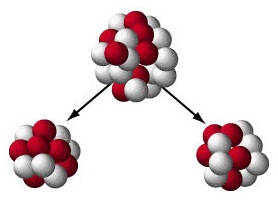Nuclear Fission Reactor
Miniaturized

Nuclear Fission |
Team Bound will use power generated from a mini nuclear fission reactor with a long lifespan. Studies have shown that nuclear fission reactors will be the best choice for the next generation interstellar missions. Bound needs approximately 250kW of power to drive its ion drive. Bound also needs power for onboard devices, computers, communication system and star tracking devices. |
Research for Power System
Initial research for the power system was based upon the Project Longshot1. This study reported a preliminary design for an unmanned probe to Alpha Centauri with a planned launch early in the 21st century.This probe use a large, long-life fission reactor with 300 kilowatts power output. The total mass of the system was 6400 kg including fuel.
Distance is one of the major constraining factors of the power system for team bound. With present technology it is easy to achieve 250 kW of power output, but the lifespan of the reactor is a major concern. Currently, mini nuclear reactors are being developed with a life span of 60-80 years. With the continuing advancement of technology, it can be possible to build a reactor that can provide power for centuries.
To travel 10.5 light years in 1000 years, Team bound will need a reactor with the following approximate specifications: 
| Reactor mass | 6000 kg |
| Shielding | 4000 kg |
| All other units mass | 20000kg |
Hence an approximate mass of the entire unit will be 30,000 kg to allow for high quality shielding due to the long-duration voyage.